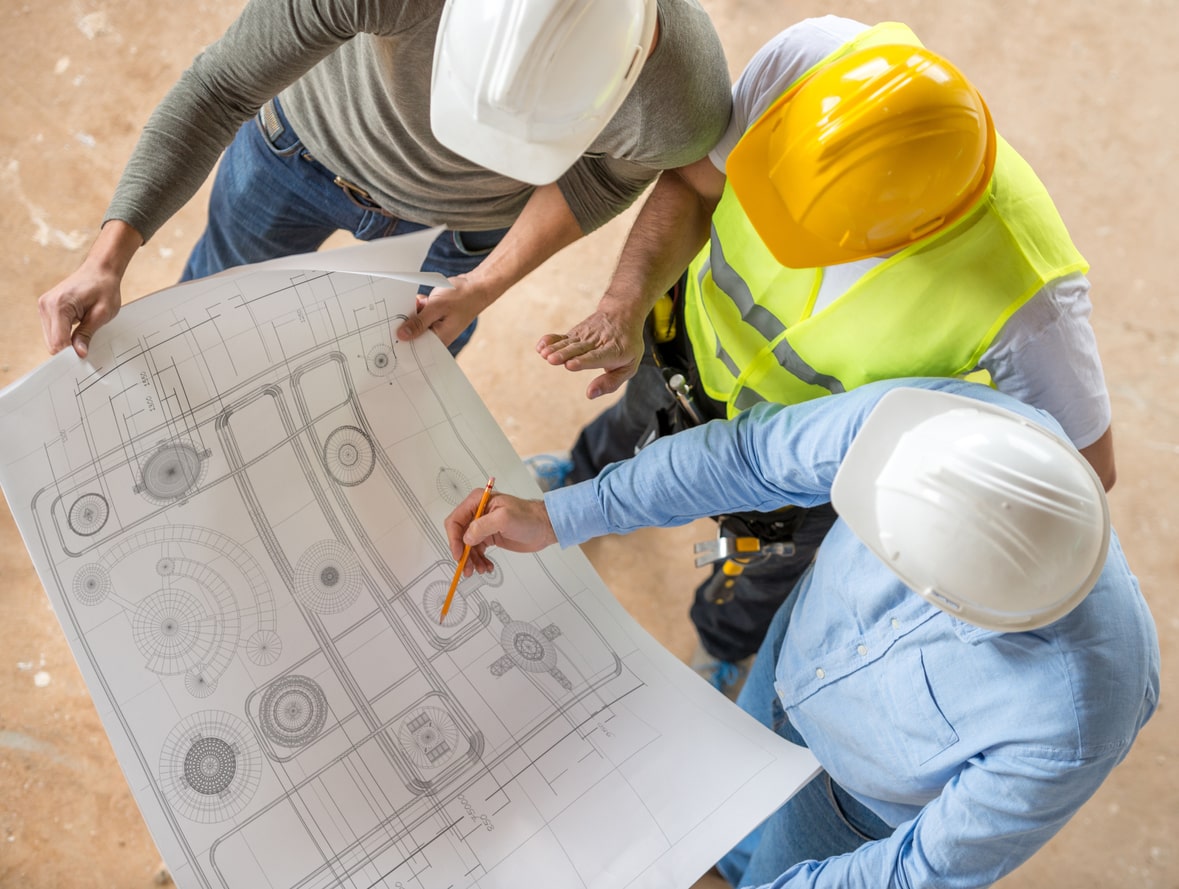Introduction to Basic Engineering

Civil Engineers
Structural engineering is the art and science of designing and making of buildings, frameworks, bridges, and other structures so that they can safely resist any forces that they may be subjected to.
Construction Engineering
A construction engineer is a civil engineer who oversees and manages a large-scale, complex construction project. These projects typically involve the buildings and the infrastructure that supports them. Construction engineers collaborate with other engineers and can manage building crews to help ensure project success.
Required skills:
- Methods and equipment
- Structures
- Construction management
- Cost estimation and analysis


Geotechnical Engineering
Geotechnical engineering is concerned with the engineering behavior of earth materials, using principles of soil and rock mechanics to solve respective engineering problems. It is a branch of civil engineering. Geotechnical Engineering explains the mechanics of soil and rock and their applications to human development. It includes the analysis, design, and construction of foundations, slopes, tunnels, retaining structures, roadways, dams, levees, wharves, landfills, and other systems made or supported by soil or rock.
Specializes in:
- Survey
- Soil mechanics and dynamics
- Earth structure
- Earthquake engineering
Structural Engineering Process
Structural engineering identifies loads to be resisted and alternatives for providing load paths (arch, truss, frame, etc.). Structures must provide safe and economical load paths (material, size, connections). Forces that apply to the structure need to be predicted.
- Determine types and magnitudes of loads
- Determine structural context:
- Geometric and geological information
- Cost / schedule / height / etc. limitations
- Generate alternative structural systems
- Analyze one or more alternatives
- Select and perform detailed design
- Implement (usually done by contractor)

Forces
A force is an influence changes the motion of an object – it can be described intuitively as a push or a pull. Forces can cause objects with mass to change their velocity – accelerate or deaccelerate. A force is a vector quantity since it has both magnitude and direction.
Axial Forces
- Acting along one axis, directly on a point or surface
Momential (Bending) Force
- Acting along an axis, at a certain distance from a point, causing a folding motion
- M = F*d
Tensile Force
- Pulling on an object – stretching it
- Steel shows “necking” when too much tensile force is applied
Compressive Force
- Pushing on an object – collapsing it
- Concrete crushes when too much compressive force is applied
Strain
- Tensile-related property
- Deformation/Length
Stress
- Compression-related property
- Force/Area
What constitutes loading?
Loading is the application of a force to an object. Materials can be subjected to many different types of loading scenarios. A material’s performance is dependent on the loading conditions. There are five fundamental loading conditions:
- Tension
- Compression
- Bending
- Shear
- Torsion
In construction, loading is a force being enacted on the structure.
- Many sources of load:
- Gravity/Weight
- Wind
- Snow
- Earthquake
- Man-made
Types of Structural Loading
Dead Loads – static, ever-present (i.e., Walls, Floors, etc.)
- Weight of the structure itself.
- Floors, beams, roofs, decks, beams/stringers, superstructure.
- Weight of immovable fixtures such as walls, cabinets, carpets, etc.
- Loads that are ‘always there.’
- Relatively constant over time.
- Also known as Permanent Loads.
Live Loads – dynamic, changing
- People, furniture, equipment.
- Temporary, short-duration, or moving loads.
- Dynamic loads may involve considerations such as impact, momentum, slosh dynamics of fluids, or fatigue.
- Change relatively slowly.
- Includes all forces that are variable within the normal life cycle, not including construction or environment.
- Loads that move or change mass or weight.
- Minimum design loadings are usually specified in the local building codes.
Dynamic Loads
- Moving loads (e.g., traffic).
- Impact loads.
- Gusts of wind.
- Loads due to cycling machinery.
- Change value rapidly or abruptly.
- Gusts of wind or dropped objects on a floor.
- May be dangerous or catastrophic if they exceed the load capacities of the structure.
- Many times the load of a slowly applied force.
- Can be a static or dynamic load.
- Period of building oscillations.
Settlement Loading
Environmental Loads
- Act as a result of weather, typography, and natural phenomena:
- Wind loads.
- Snow, rain, and ice loads.
- Seismic loads.
- Ponding loads.
- Loads from fluids or floods.
- Dust loads.
- Lateral pressure of soil, groundwater, or bulk materials.
- Temperature changes leading to thermal expansion cause thermal loads.
- Earthquake loads
- Structure loading when the base is shaken.
- Response of structure is dependent on the frequency of motion.
- Resonance is when frequencies match the natural frequency of the structure.
Load Paths in Structures
- Load Path is the term used to describe the path by which loads are transmitted to the foundations.
- Different structures have different load paths.
- Some structures have only one path.
- Some have several (redundancy is good).
What should we build our structures out of?
Common Structural Materials:
- Timber
- Masonry
- Concrete
- Steel
- Composites

How do we judge the materials?
Common Material Properties:
- Strength
- Tensile/Compressive
- Ability of a material to withstand loading.
- Tensile strength – ability of a material to withstand a pulling force.
- Steel is good at this, but concrete performs very poorly.
- Compressive strength – ability of a material to withstand a pushing force
- Wood, concrete, steel, and masonry perform well.
- Ability of a material to withstand loading.
- Tensile/Compressive
- Density
- Mass per unit volume of a material
- Units – mass/vol – kg/m3 or lb-m/ft3.
- Typically, materials with a high density are very strong and offer great protection.
- However, a high density means that they are heavy and difficult to work with $$$$$.
- Mass per unit volume of a material
- Hardness
- Ability of a material to resist permanent deformation under a sharp load
- Relates to the elasticity of a material.
- Diamond is a very hard substance. If we built a wall out of diamond, we could be sure that very few things would scratch it.
- However, diamond is incredibly expensive and not as tough as other engineering metals. It wouldn’t stand up as well in impact loading versus other materials.
- Ability of a material to resist permanent deformation under a sharp load
- Ductility / Brittleness
- Ability of a material to deform without fracture
- Materials with high ductility indicate structural failure without a sudden collapse.
- Ability of a material to deform without fracture
- Elasticity
- Ability of a material to deform and return to its original shape.
- Important quality
- Young’s Modulus.
- Ratio of stress to strain:
- Stress = Force / Area (lbs./in2 or N/m2).
- Strain = Deformation / Length (unitless).
- Generates a stress-strain graph.
- Related to the ductility of a material.
- Toughness
- Ability of a material to resist fracture when stressed (amount of energy absorbed per unit volume).
- Units – J/m3 or Lb-f/ft3.
- Area under the stress-strain curve, evaluated from 0 to the desired strain.
- Ability of a material to resist fracture when stressed (amount of energy absorbed per unit volume).
Various properties are important in structural materials.
How do the common materials stack up against each other?
TIMBER
- Advantages:
- Cheap and renewable resource.
- Good in Tension – ~40 MPa.
- Disadvantages:
- Susceptible to fire, nature.
- Not very hard.
- Not very strong.
- Limits on shape and size.
MASONRY (Concrete blocks, clay bricks)
- Advantages:
- Large compressive strength.
- Cheap.
- Good thermal properties – holds heat well.
- Disadvantages:
- Not a cohesive material. The strength could depend on the mortar and other factors.
- Poor tensile strength unless reinforced.
- Heavy material
- Requires skilled laborers to use. $$$$$.
- Height restriction.
- Susceptible to weather.
CONCRETE (Combination of water, cement, small aggregate, and large aggregate.)
- Advantages:
- Very versatile – can be modified with admixtures for different effects.
- High compressive strength (4~7 ksi).
- Fire resistant.
- Many diverse sizes and shapes – formwork.
- Disadvantages
- Long curing time.
- Low tension strength (~0.4 ksi).
- Fails in shear unless reinforced.
- Fairly heavy material to work with.
STEEL
- Advantages:
- High tensile and compressive strength (A36 Steel ~ 60 ksi).
- Wide number of varieties, depending on the need:
- Carbon steel.
- Stainless steel.
- Galvanized steel.
- Elastic material.
- Ductile material.
- Many shapes and sizes.
- Inherent Benefits of Steel Framing:
- Steel has the highest strength-to-weight ratio of any framing material.
- Non-combustible – steel will not contribute fuel to the spread of a fire.
- Steel is termite resistant.
- Steel is rodent resistant.
- Steel is dimensionally stable: it will not rot, warp, crack or shrink.
- Lower builder’s risk insurance.
- Permanently straight walls.
- No callbacks for nail pops.
- Ground against electrical storms.
- Structurally maintenance-free.
- No toxicity contribution – (free of resins or chemicals commonly present in other framing materials.
- Consistent material quality – no regional variation.
- Inorganic – not vulnerable to mold.
